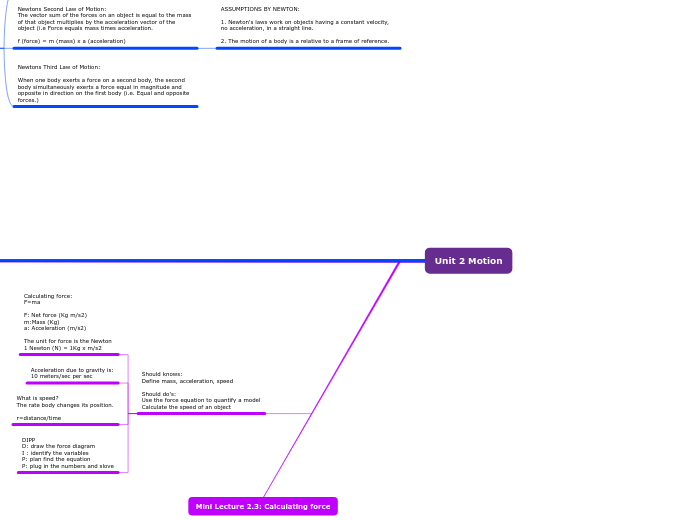av Rianne Jayden Ulandez 2 år siden
396
Mind Map Assignment

av Rianne Jayden Ulandez 2 år siden
396

Mer som dette
-Normal force (mass): increase the contact force -Surface texture: increase surface areas= contact force -Surface area (amount of contact) -Motion: decreases the contact force
Displacement: -a vector quantity distance and direction traveled by an object CHANGE IN MOVEMENT Vector quantities: Displacement, Direction, Acceleration, Velocity
Distance: -A scalar quantity -Distance traveled by an object during its motion Scalar quantities: Length, Area, Volume, Speed, Mass, Density
WE USE FREE BODY DIAGRAMS
Fg : Force of the object or weight Fn : Normal force the force perpendicular to the surface and object is on contact with Ff : Force of friction (small f is always friction) Fa : applied force- the push of pull BIG F = force
-Gravity has a negative value -Normal force has a positive force -Forces moving left are negative -Forces moving right are positive
Attract or repel, even from a distance
Example -Magnetic force -Electric force -Gravitational force
Contact Force: A force that requires contact between objects. Examples are tension, normal force, and friction.
-Applied force -Spring force -Drag force -Frictional force -Normal force (If there is no contact between surfaces, there is no normal force
Force: energy that changes the motion of a body
Newtons Third Law of Motion: When one body exerts a force on a second body, the second body simultaneously exerts a force equal in magnitude and opposite in direction on the first body (i.e. Equal and opposite forces.)
Newtons Second Law of Motion: The vector sum of the forces on an object is equal to the mass of that object multiplies by the acceleration vector of the object (i.e Force equals mass times acceleration. f (force) = m (mass) x a (acceleration)
ASSUMPTIONS BY NEWTON: 1. Newton's laws work on objects having a constant velocity, no acceleration, in a straight line. 2. The motion of a body is a relative to a frame of reference.
Newtons First Law of Motion: An object either remains at rest or concintues to move at a constant to move at a constant velocity, unless acted upon by an external force. (i.e.: Objects in motion tend to stay in motion. Objects at rest tend to stay at rest.)